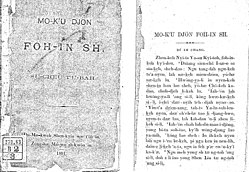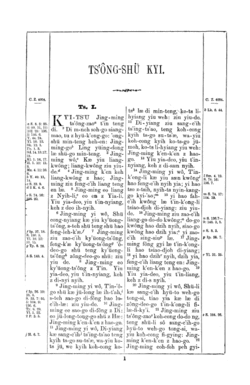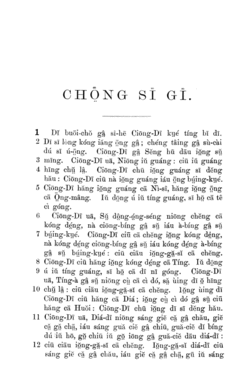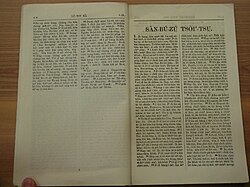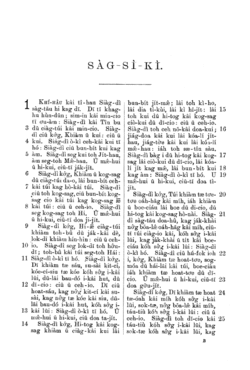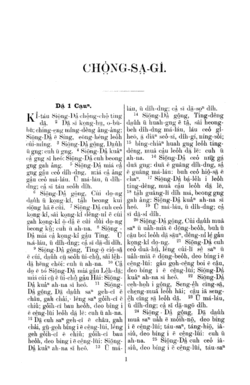List of Chinese Bible translations Last updated December 24, 2025
This is a list of Bible translations into Chinese .
Bible translations into Chinese began with translations made by the Church of the East under the Tang dynasty into Old Chinese . However, no surviving manuscripts exist, and the only surviving evidence of this is the Nestorian Stele and the six other Chinese Christian texts of that period, named the Jingjiao Documents , and recently edited by Alexis Balmont in 2025. [ 1]
The next instance of Bible translations into Chinese languages subsists in unpublished manuscripts by individual Roman Catholic priests in the sixteenth century and individual Protestant missionaries in the early nineteenth century. The first complete translation to be published was that of Joshua Marshman in 1813, followed by that of Robert Morrison in 1823. A group of Protestant missionaries in Hong Kong in 1843 started a collaborative translation. The New Testament of their so-called "Delegates Version" was published in 1850 and the Old Testament in 1853. A translation of the Old Testament by Karl Gutzlaff , first published in 1840, was widely distributed and was used by the leaders of the Taiping Rebellion as the basis of their theological study.
The second half of the century saw the publication of Chinese Bibles in regional languages using romanization rather than Chinese characters , the first works printed in the regional languages. The Classical Chinese of the Delegates Version could not be understood when read aloud, and towards the end of the century the national missionary body started a revision which used vernacular Chinese . The resulting Union Version , published in 1919, became the standard translation for Protestants and was adapted and published in different forms, including Braille . A Chinese New Version was published in 1992 and a Revised Chinese Union Version in the early twenty-first century.
The Studium Biblicum Version , now the standard Chinese Bible for Catholics, was started in the 1930s and published in 1968. Starting in the 1850s, there have been three Russian Orthodox translations .
Mandarin Chinese The following lists translations in the Northern Mandarin, Southern Mandarin , Western Mandarin and Hankou dialects of Mandarin Chinese :
Northern Mandarin New Testament of Robert Morrison (馬禮遜 马礼逊 Mǎ Lǐxùn Old Testament (Samuel Isaac Joseph Schereschewsky ), 1875 Internet Archive New Testament (Peking Committee), 1870 New Testament of Griffith John (杨格非译本 Romanized Vernacular Version New Testament, 1889 Portions of New Testament for the Blind Chinese Union Version (和合本 Héhéběn United Bible Societies (HK), Amity Printing Company (PRC) Studium Biblicum Version , Scotus Chinese Version (思高本 Sīgāoběn Amity Printing Company (PRC) Today's Chinese Version (現代中文譯本 Xiandai zhongwen yiben United Bible Societies (HK), Amity Printing Company (PRC) New Chinese Version (新译本 Xinyiben 环球圣经会 Chinese Living Bible (当代圣经 Dangdai Shengjing International Bible Society 1998 Pastoral Bible (Chinese) (牧灵圣经 Muling Shengjing Amity Printing Company (PRC) New World Translation of the Holy Scriptures (NWT 新世界译本 Xīnshìjiè-Yìběn Chinese Standard Bible (CSB 中文标准译本 Zhongwen biaozhun yiben Chinese NET Bible (NET圣经 中译本 Contemporary Chinese Version (CCV), The New Testament, 《圣经.新汉语译本》 汉语圣经协会 Chinese New Living Translation 《圣经.新普及译本》 汉语圣经协会 Contemporary Chinese Version (CCV), The New Pentateuch, 《五經.新汉语译本》 汉语圣经协会 Worldwide Chinese Bible 《環球聖經譯本》 環球聖經公會 Hankou dialect Book of Mark, 1921 using the Wangchao phonetic system. [ 2] Wu Chinese The following lists translations in the Suzhou , Shanghai , Ningbo , Hangzhou , Jinhua , Wenzhou , and Taizhou (Zhejiang) dialects of Wu Chinese :
Bible in Soochowese Suzhou dialect Romanised (Gospel of Mark ), published by the American Bible Society Hangzhou dialect Romanized vernacular versions
New Testament (parts), 1877 by the English Bible Society. Gospel of John, 1879 by the Anglican Missionary G. E. Moule Gospel of Matthew, 1880 by the English Bible Society. Jinhua dialect Romanized vernacular versions
Wenzhou dialect Matthew-Acts, 1890 The Four Gospels and Acts, in Wenchow was published in 1894 under the title Chaò-chî Yi-sû Chī-tuh Sang Iah Sing Shī: Sz̀ fuh-iang tà sź-du ae-djüe fa üe-tsiu t'û 救主 耶稣 基督 新 约 圣 书: 四 福音 及 使徒行传 翻 温州语 [ 3] Taizhou dialect Bible in Taichow (Taizhou) Romanised (Genesis ), published by the British and Foreign Bible Society Romanized vernacular versions
New Testament, Ngô-he kyiu-cü yia-su kyi-toh-keh sing-iah shü. Te-tsiu tu-wa; di-nyi-tʻao ing [ 4] Northern Min The following lists translations in the Jian'ou and Jianyang dialects of Northern Min :
Bible in Jian'ou Romanised (Genesis ), published by the British and Foreign Bible Society Romanized vernacular versions
Jianyang dialect Romanized vernacular versions
Gospel of Mark, 1898 by the English Bible Society. Gospel of Matthew, 1900 by the Methodist Episcopal Mission Press. Translated by Hugh S. and Minnie Phillips of the American Bible Society. Eastern Min The following lists translations in the Fuzhou dialect of Eastern Min :
Fuzhou dialect Character colloquial versions
Romanized vernacular versions
Southern Min The following lists translations in the Amoy , Shantou , Teochew , and Hainan Junjiahua dialects of Southern Min :
Amoy dialect Romanized vernacular versions
Old Testament, 1852–1884 New Testament, about 1853-1873 Gospel of Matthew, for Blind, 1888 Shantou dialect Character colloquial versions
Genesis, 1879 Ruth, 1875 Matthew–1 Corinthians, Philippians, 1 Thessalonians–Titus, Hebrews, 1 2 3 John, 1880–1884 Romanized vernacular versions
Genesis, 1888 Jonah, 1888 Gospel of Matthew, 1889 Gospel of Mark, 1890 Gospel of Luke, 1876 Acts, 1889 James, 1888 Kiù-tsú Iâ-sou Ki-tok kâi Sin-ieh Tshuân-tsṳ Chiēⁿ-Kńg Má-thài kàu Sài-thû Su-kat-lân: Tãi Eng-kok lãi gūa Siàⁿ-tsṳ-hũe Ìn [ 8] Teochew dialect Bible in Teochew Romanised (First Book of Samuel ), published for the British and Foreign Bible Society Romanized vernacular versions
Kū-ieh sàn-bú-zṳ́ ẽ-kńg tshûan-tsṳ e̍k-tsò tiê-chiu pe̍h-ūe Sùaⁿ-thâu, Loí-pài-tn̂g, Hon̂g-soh-hṳn Ìn New Testament, 1915 by English Presbyterian Missionary societies. Gan Chinese The following lists translations in the Shaowu and Jianning dialects of Gan Chinese :
Shaowu dialect Romanized vernacular versions
Book of James, 1891 by the American Board of Commissioners for Foreign Missions. Jianning dialect Gospel of Matthew, 1896 by the American Bible Society. Gospel of John, 1897 by the Bible Society of Great Britain in London. Hakka The following lists translations in the Tingzhou , Wujingfu Hakka, Swatow Hakka, and Taiwan Siyen Hakka dialects:
Character colloquial versions
Genesis and Exodus, 1886 Psalms, 1890 New Testament, 1883 Old Testament and New Testament, 1930 Romanized vernacular versions
Das Evangelium des Matthaeus im Volksdialekte der Hakka-Chinesen Rudolf Lechler New Testament, 1860–1883 New Testament (Bible Society in Taiwan), 1993 (with the Psalms); Proverbs 1995. [ 9] Tingzhou dialect Gospel of Matthew (Romanised), 1919 五经富 Taiwan Siyen Hakka dialect The following lists translations in the Guangzhou , Lianzhou, and Yangcheng dialects of Yue Chinese :
Translations into Cantonese include:
Character colloquial versions
Romanized vernacular versions
Gosepel of Luke, 1867 Gospel of Mark, after 1890 Lianzhou dialect Gospel of Matthew, 1904 by the American Bible Society. Translated by the missionary Eleanor Chesnut . Gospel of Mark, 1905 Gospel of Luke, 1905 Gospel of John, 1905 Yangcheng dialect Gospel of Matthew, 1862 by the American Presbyterian Church. Translated by Charles F. Preston . Gospel of John, 1862 Gospel of Luke, 1867 by the English Bible Society. Translated by Wilhelm Lauis . Notable translations Chinese Bible used by the Filipino-Chinese Anglican Community in Saint Stephen 's Pro-Cathedral under the Episcopal Church in the Philippines Robert Morrison. 耶酥基利士督我主救者新遺詔書 : 俱依本言譯出 Ye Su Ji Li Shi Du Wo Zhu Jiu Zhe Xin Yi Zhao Shu : Ju Yi Ben Yan Yi Chu [ 10] 遺詔全書 神天聖書 Lassar-Marshman Version (遺詔全書 Morrison-Milne Version (神天聖書 Delegates Version (委辦譯本 代表譯本 Archimandrite Gury's New Testament (新遺詔聖經 聖詠經 [ 11] [ 12] Chinese Union Version (和合本 ), 1904–1919 Chinese Union Version (和合本 文理和合 Studium Biblicum Version (思高譯本), 1935–1968 New Testament and paraphrase of Psalms by John C. Wu (新經全集 聖詠譯義 [ 13] [ 14] Studium Biblicum Version (思高譯本 , 1968) Lü Zhenzhong's version of the Bible (呂振中譯本 , 1970) Chinese Living Bible (當代聖經 , 1974) Today's Chinese Version (現代中文譯本 ), Dangdai shenjing New Chinese Version (聖經新譯本 ), 1993 Pastoral Bible (Chinese) (牧靈聖經 New World Translation (聖經新世界譯本 漢語版 ), 2001 Recovery Version (聖經恢復本 ), 2003 Chinese Contemporary Bible (当代译本 [ 15] Chinese Standard Bible (中文標準譯本 [ 16] Chinese NET Bible NET聖經(中譯本) , 2011–2012 Contemporary Chinese Version (CCV), The New Testament, 《新約.新漢語譯本》 Chinese New Living Translation (CNLT), 《聖經.新普及譯本》 Contemporary Chinese Version (CCV), The Pentateuch, 《五經.新漢語譯本》 The New Testament in English and Mandarin, 1904. [ 17] The New Testament in English and Mandarin, American Bible Society. 1885 [ 18] This page is based on this
Wikipedia article Text is available under the
CC BY-SA 4.0 license; additional terms may apply.
Images, videos and audio are available under their respective licenses.
